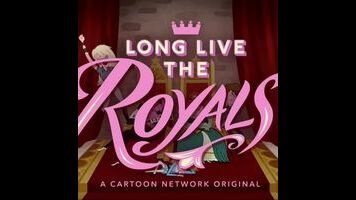The silly, absurd Long Live The Royals never justifies its miniseries format

Based on a pilot by Regular Show supervising producer Sean Szeles, Long Live The Royals is Cartoon Network’s third miniseries, after Over The Garden Wall and Stakes (the Marceline-focused Adventure Time story), but you’d be hard-pressed to figure out why. The four episodes that make up the miniseries—“Yule Scare,” “Punk Show,” “Snore Much,” and “The Feast”—feel more like a series of proof-of-concept pilots, and less like the parts of a stand-alone event. The episodes are fine, funny even, but unlike Over The Garden Wall—which embraced its limited format to tell a complete emotional tale—by the fourth episode, Long Live The Royals has barely gotten started, ultimately feeling like a goofy mashup of Regular Show and The Marvelous Misadventures Of Flapjack.
The focus is on a royal family of goofballs, their high-class, petty lifestyle set against the backdrop of a surrealist medieval age. Each episode focuses on one member of the family, following Prince Peter (Kieran Culkin), Princess Rosalind (Gillian Jacobs), Queen Eleanor (Wendi McLendon-Covey), or Prince Alex (Nicki Rapp) through a weird, if relatively bland, storyline. (Rounding out the royal family is Jon Daly as King Rufus.) Those storylines examine a single dilemma through the main character’s eyes, like the queen’s insecurity about her snoring problem, or young Alex’s desire to prove himself by finding the inspiration for the festival that frames all four episodes, the mythical Yule Hare. These episodes are fine in and of themselves, with the Rosalind-centric “Punk Show” being the most well-developed. But on the whole, they aren’t anything we haven’t seen before, nor are they visually or aesthetically interesting enough to stand apart from other Cartoon Network shows similar to Long Live The Royals.
The strongest part of the series is its wildly anachronistic fusion of medieval traditions and environments with modern-day technologies and attitudes. The historical setting is peppered with contemporary comedic touches: The local peasant bar is stocked with guitars and stage lights, dismissed servants receive severance packages, and there’s even an apparent furry living among the merry men of the forest. These elements butt up against each other to great effect, whether it’s the queen surveilling one of her sons and “enhancing” the image with a series of classically styled paintings, or two characters constructing a robot, one confusing the other with his reference to a “movie.” (The properly confounded response: “What’s a movie?”) Even the previously mentioned severance packages get in on the time-warping fun, through the involvement of tiny guillotines.
These are all great moments, but Long Live The Royals isn’t a series that congeals into anything poignant, revelatory, or even comically significant. The final episode re-enforces the power and affection of family (even if that family is, as one royal subject states, “all terrible”), without getting into the nitty-gritty of how they really function within that family unit. Part of that is due to the miniseries’ makeup, containing only four 11-minute episodes, as compared to the 10-part Over The Garden Wall. (That might also explain Cartoon Network’s seemingly minimal promotional efforts for Long Live The Royals). The individual stories are fun, but nothing that hasn’t been done before. It also never really explores or examines what it means to be a family (nor does it touch on the socioeconomic disparity between the Royals and their impoverished subjects, outside a few decent jokes), leaving Long Live The Royals only wishing it was a full series to do so. Not because it’s amazing, only because it never got a chance to finish the stories it clearly wants to tell.